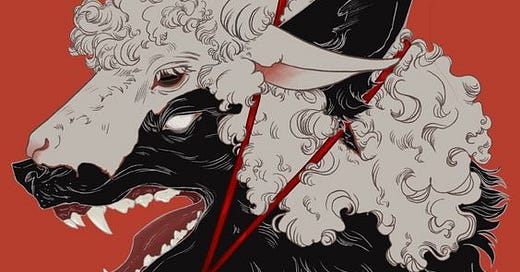“Life imitates Art far more than Art imitates Life” ~ Oscar Wilde
In Dilwale Dulhania Le Jayenge (DDLJ), the main female character, Simran, gets drunk one night and forgets what happened the night before when she wakes up the next morning. Raj, the male protagonist, pretends that they actually “did it”, opening his shirt to show his chest scattered with comical lipstick marks all over. Simran starts to sob, panicking about the implications that would have on her. But then, seeing her distress, he promises her that he was only fooling about and that he would never do anything that would ruin her honor: aka. her virginity.
A girl’s virginity is priced over everything else – especially virginity before marriage – because it is a sign of purity and goodness of the soul.
In current Indian society, rapists feel guilty for assaulting young girls not because of the severe physical, emotional and psychological damage that they inflict on them, but rather, because such girls are no longer virgins and therefore, now tainted for marriage.
Historically, a woman’s lack of sexuality and austereness were prized above everything else. It meant a woman was untainted, untouched by the “evilness” and “filth” of desire. But such desire is only thought of as filthy when it comes to women. On the contrary for men, taking a woman to bed was an assertion of their masculinity rather than its degradation.
And yet on the other hand, art, media and therefore, culture, have pervasively perpetuated the “male gaze”. The male gaze refers to how women are reduced to sexual beings and objects – bodies that are there to arouse desire in men.
Countless paintings depict women naked alone in a bed, in a field with other women or surrounded by men, who are almost always fully dressed. Western Renaissance paintings highlight the whiteness and beauty of the skin, and seem to focus on the woman’s extreme desirability, but at the same time, her pureness. There is innocence tainted in the way they are depicted – as creatures who are unaware of the effect that they have on men – and yet at the same time, they can also be shown as enticing men, that their mere presence is what draws and allures men.
Women are reduced to the mere status of an object, a process that is called “objectification”. According to philosopher Immanuel Kant, “objectification involves the lowering of a person, a being with humanity, to the status of an object.” He believed that “sexual love makes the loved person an Object of appetite; as soon as the appetite has been stilled, the person is cast aside as one casts away a lemon which has been sucked dry. …. as soon as a person becomes an Object of appetite for another, a person becomes a thing and can be treated and used as such by everyone.” In this way, a person is degraded, subordinated and dishonoured when only seen through a sexual object.
The objectification of women in the media is not only no longer uncommon, but in fact, pervasive. Books, movies, TV shows, songs and music videos continue to reduce women to their body and sexuality to appease and entice male audiences.
In Bollywood item songs, half-naked women are shown with crowds of men heckling and grabbing for them. In these depictions, she flaunts her sexuality and provokes an intense and almost feral response from men. Her sexuality is her power, but she is reduced to an image, an object that elicits desire. Therefore, her worth is only restricted to her body. She is a discardable being, whose shelf-life is only as long as her appeal lasts.
Not only are the male characters in the movie involved in objectifying her in the name of “love”, but the viewers are also forced to take part in this process. The camera lingers on her chest, her stomach, her legs, her hips, which are exposed in a manner to elicit or appease the male gaze.
We have countless Bollywood movies in which men are actively disrespecting the wishes of women, in which their rejection is just a part of the being playing “hard to get” because in the end, these women are shown to end up completely smitten by them. Women are touched without their permission as a form of “flirting”. A male character “falls in love” with a woman he glimpses at and then endlessly pursues her despite her irritation.
In a patriarchal society, women are constructed to become objects of male pleasure. Catherine MacKinnon looked at this gaze through the lens of pornography, in which women are made to be submissive and infantilised. They are treated by objects, “for the gaze that eroticizes the despised, the demeaned, the accessible, the there-to-be-used, the servile, the child-like, the passive, and the animal. That is the content of sexuality that defines gender female in this culture, and visual thingification is its method.”
Laura Mulvey looks at the scopophilia (the Freudian term referring to the neurotic sexual pleasure of looking) in Hollywood films and the presentation of women in these films, which is very applicable to Bollywood films. Men are usually the protagonists, with women as decorative or sexual objects to elicit the desire and pleasure of male characters and male audience-members. Here, beauty is “at the heart of oppression”. The use of beautiful women or the pursuit of them is shown as a hedonistic concept: beauty elicits and engenders pleasure. However, some forms of this pleasure can be exploitative and sadistic to the individual and to society as a whole. Ways in which women are looked at or sometimes kissed are used to demean their humanity rather than respect. They are commodified and made as something to be consumed rather than a person to have mutual relationships with. We can see this especially in the Dhoom series, where the women could not be more commodified, sexualised and submissively seductive.
This creates contradicting expectations of women. On the one hand, women are expected to be virginal saints before marriage: a person devoid of sexual desire. And on the other, men have reduced women to sexual objects, ones that reflect their own desires through art, media and music for centuries.
This horribly twisted match made in hell is the reason why people accuse rape victims: clearly they were “asking for it”, these women were “sexualising themselves” or stepping the boundary or out too late. And at the same time, men are given all the permission in the world to reduce a woman to her body. Media, movies, shows and culture at large gives them the permission to act the way they do.
It is such a pervasive problem and it is deep rooted in patriarchal expectations of women and men. Men are default seen as creatures who desire sex – who are brash and unafraid of sexual encounters and whose sexuality is shown as a sign of manhood rather than lack of it.
However, women are traditionally not seen as that. Women are supposed to be submissive, listen to her husband and do as he pleases. Women are supposed to allow men to exert their desires upon them. Whereas a man’s value elevates with his sexuality, a woman’s value degrades. This reinforces the hierarchical dynamics between men and women – in which men are the ones who are active, who are more experienced and therefore have more power, and women are supposed to be passive, listening, understanding, wilfully naïve so that men can project their ideas on her.
These notions reinforces patriarchy — innocence and purity is venerated in women because to be more experienced than a man means you have more power over him. When women do have more sexual experience or exhibit their desires, they are villainized and vilified. Derogatory words to describe someone who is promiscuous are almost always used against women (for example sl*t and wh*re). This is not done when men decide to project their own sexuality on women through art and media, but rather when a woman shows her sexuality the way men often do. However, when men do, by flexing their body, its strength and its desirability – they are not reduced to mere sexual objects like women are but are elevated as a man with success and power. Whereas if women do, they are degenerated, not only by men, but also by other women.
These expectations and notions about sex harms both men and women a lot. When men are seen as sexual creatures who always want to “do it”, rape seemingly becomes about needing to satisfy one’s desire, rather than a question of power, abuse and authority. An extremely problematic post went viral online where a (fairly unknown) film director, Daniel Shravan, talked about how “rape without violence should be legalised” (ie. in which the victim is not killed) because women should cooperate with men: “girls should not deny [the] sexual desires of men,” so that they aren’t murdered. He said that instead of calling the police, women should carry around tampons with them. The idea that a woman must cooperate and submit to the desires of men puts blame on her rather than her rapist, and reinforces the idea that what she feels and wants is not as important as a man. And also, there is no such thing as “rape without violence” because RAPE IS VIOLENCE. It is violation of the body, mind and soul. Rape is not about sex, it’s about power and exploitation.
On the flip side, by framing men as people who always want to have sex, abuse and rape against men and boys is not taken as seriously. One of the most famous examples of this is the way Justin Bieber has been treated in the music industry. There are so many disturbing clips of things happening to him in talk shows, music awards and in general where older women have forcedly kissed him, asked him extremely weird questions about nudity, and act extremely inappropriately which would have definitely raised eyebrows if Justin Bieber had been a girl. There is a clip of Katy Perry grabbing his butt (because she wanted to know what a Bieber-butt felt like), James Corden (who hosts The Late Late Show) going really uncomfortably close to Bieber while asking him weird questions, and just people touching him in ways that should not be okay (even if that means grabbing his arm without his consent). And for so long, this has not been discussed and looked at as a major problem. With the P. Diddy scandal unfolding left, right and centre, we are finally seeing that the things that all of these things that were happening in public was far from what was truly happening to Justin Bieber.
Because men are seen as default creatures actively seeking out sex, and women as passive receivers of that, we don’t see the abuse that is happening right in front of us. Sexual assault against men in so many movies and shows are done for the laughs (in Kal Ho Naa Ho, there is a scene in which Saif’s character is being inappropriately prayed on by two women but it’s shown as comedic, as he struggles to get away from them).1
Due to this notion, we see men as natural pursuers in a relationship and women as recievers. Not only is this in movies, but also in most Indian songs: Mehndhi Laga Ke Rakhna is an example I can think of off the top of my head.
And when this goes to its extreme, movies begin to normalise men stalking, harassing and violating a woman’s consent as an act of love. In Dil Se, SRK’s character does this to the female lead, going as far as sexually harassing her by forcefully kissing and grabbing her. I don’t understand in which universe you could justify these acts as things “ordinary” people do in “the name of love”. It is so common in media to normalise this pursuit of love that it has changed that way we even think of romance and relationships. And no, the industry should not continue to “show what sells” because even the fact this sells in the first place tells us lot of alarming things about our society, values and perceptions of love.
As I wrote in my post about the Kolkata rape case: will this ever end?
We look and call rapists monsters. We make it seem like they are some form of rarity, some pure evil that has descended on earth, an animal amongst men, a devil in the night. But the reality is — like the woman who are raped — these men too are sons, fathers and brothers. These men were not born as monsters, psychopaths or blood-thirsty sadists. They are men of our society and culture, products of our media and norms, traditions and customs.
There have been countless incidents of men stalking women because Bollywood (and even Hollywood) says that is how you get a woman.
As I wrote in my post on DDLJ:
“A woman’s rejection is not taken seriously, only her acceptance is — and this has implications for the way we look at romance between men and women…
The most problematic parts of these movies is that after all the stalking, the hero gets the girl in the end.
It… tells young men and boys that it is okay not to take a woman’s displeasure and “no” seriously. This has much darker implications. It implies that a woman’s rejection actually secretly means a “yes”. In Hindi films, male heroes sometimes stalk their love interests and don’t take the heroine’s discomfort or irritation seriously. It conveys the message that these things are just the sort of things you have to do to “find love” which isn’t true. This lack of understanding regarding consent aggravates and results in broader societal issues of female safety and justification of rape. It is exploitative and asserts male power over a woman. (DDLJ post)
We need to seriously rethink the way we look at rape, love and consent in our society. We have to openly discuss about sex and sexual expectations. Because this should be blatantly clear by now: rape is NEVER the victim’s fault. And rape does not only happen against women, it also happens against men. We need to start looking at the media around us and seeing what messages it is giving us, what things it is normalising under the name of what.
If you don’t take a “no” seriously, you should not be taking a “yes” seriously either.
Here are the two posts that I mentioned above:
I got so much love after writing the first one… thank you for reading my words and I’m so glad that it resonated with you. Definitely check this out if you enjoyed this post.
I even discuss some of these ideas in:
Other articles that I would recommend on rape culture that has stuck with me:
did you say no? are you sure? are you sure you said it loud enough? by
(incredibly written - beyond incredible)
Another article that is fantastic (and highly underrated):
Also a special shout out to
for being a better proof-reader than Grammarly. She read this first and pointed out so many little things I didn’t spot. Read her writing, you are missing out if you don’t… she’s fantastic! My favourite posts of her’s include scattered, me and do not resuscitate. please. (She’s the next Ocean Vuong, I’m telling you… I should get my autograph soon).A source that I found really useful: Feminist Perspectives on Objectification - Stanford Encyclopedia of Philosophy
Thank you for reading!
Lots of love,
Aastha <3
There are two videos by Pop Culture Detective on male assault. I’ve not watched them yet but this guy’s content is genuinely fantastic, where he examines what movies tell us about culture and gender: Sexual Assault of Men Played for Laughs - Pt. 1 Male Perpetrators; Pt 2 Female Perpetrators








In Bollywood movie, male abuse is often portrayed for laughs I think. But remember how that girl literally ran to a bus in Robot (I think that's what ash and chiiti's movie is called ) when she was seen bare. God such is perception here. But I also know things are shifting in the real world. So there's hope for movies to get better and the discoure to get more inclusive as well.
So powerful and profound Aastha!! Felt every single word of this 👏🏻💯